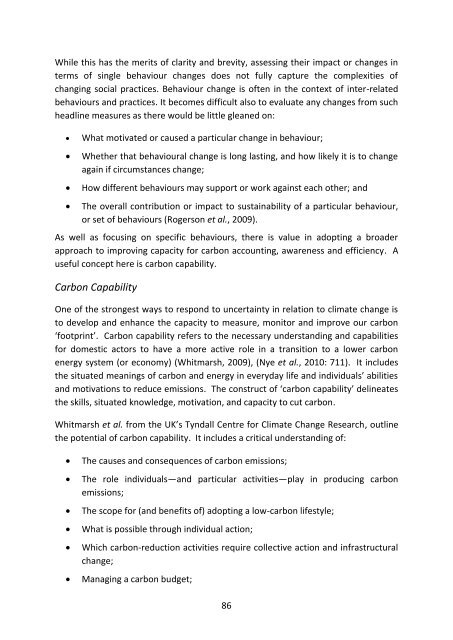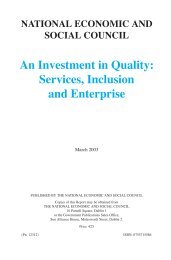Social and Behavioural Aspects of Climate Change - the NESC ...
Social and Behavioural Aspects of Climate Change - the NESC ...
Social and Behavioural Aspects of Climate Change - the NESC ...
- No tags were found...
Create successful ePaper yourself
Turn your PDF publications into a flip-book with our unique Google optimized e-Paper software.
While this has <strong>the</strong> merits <strong>of</strong> clarity <strong>and</strong> brevity, assessing <strong>the</strong>ir impact or changes interms <strong>of</strong> single behaviour changes does not fully capture <strong>the</strong> complexities <strong>of</strong>changing social practices. Behaviour change is <strong>of</strong>ten in <strong>the</strong> context <strong>of</strong> inter-relatedbehaviours <strong>and</strong> practices. It becomes difficult also to evaluate any changes from suchheadline measures as <strong>the</strong>re would be little gleaned on:What motivated or caused a particular change in behaviour;Whe<strong>the</strong>r that behavioural change is long lasting, <strong>and</strong> how likely it is to changeagain if circumstances change;How different behaviours may support or work against each o<strong>the</strong>r; <strong>and</strong>The overall contribution or impact to sustainability <strong>of</strong> a particular behaviour,or set <strong>of</strong> behaviours (Rogerson et al., 2009).As well as focusing on specific behaviours, <strong>the</strong>re is value in adopting a broaderapproach to improving capacity for carbon accounting, awareness <strong>and</strong> efficiency. Auseful concept here is carbon capability.Carbon CapabilityOne <strong>of</strong> <strong>the</strong> strongest ways to respond to uncertainty in relation to climate change isto develop <strong>and</strong> enhance <strong>the</strong> capacity to measure, monitor <strong>and</strong> improve our carbon‘footprint’. Carbon capability refers to <strong>the</strong> necessary underst<strong>and</strong>ing <strong>and</strong> capabilitiesfor domestic actors to have a more active role in a transition to a lower carbonenergy system (or economy) (Whitmarsh, 2009), (Nye et al., 2010: 711). It includes<strong>the</strong> situated meanings <strong>of</strong> carbon <strong>and</strong> energy in everyday life <strong>and</strong> individuals’ abilities<strong>and</strong> motivations to reduce emissions. The construct <strong>of</strong> ‘carbon capability’ delineates<strong>the</strong> skills, situated knowledge, motivation, <strong>and</strong> capacity to cut carbon.Whitmarsh et al. from <strong>the</strong> UK’s Tyndall Centre for <strong>Climate</strong> <strong>Change</strong> Research, outline<strong>the</strong> potential <strong>of</strong> carbon capability. It includes a critical underst<strong>and</strong>ing <strong>of</strong>:The causes <strong>and</strong> consequences <strong>of</strong> carbon emissions;The role individuals—<strong>and</strong> particular activities—play in producing carbonemissions;The scope for (<strong>and</strong> benefits <strong>of</strong>) adopting a low-carbon lifestyle;What is possible through individual action;Which carbon-reduction activities require collective action <strong>and</strong> infrastructuralchange;Managing a carbon budget;86
















